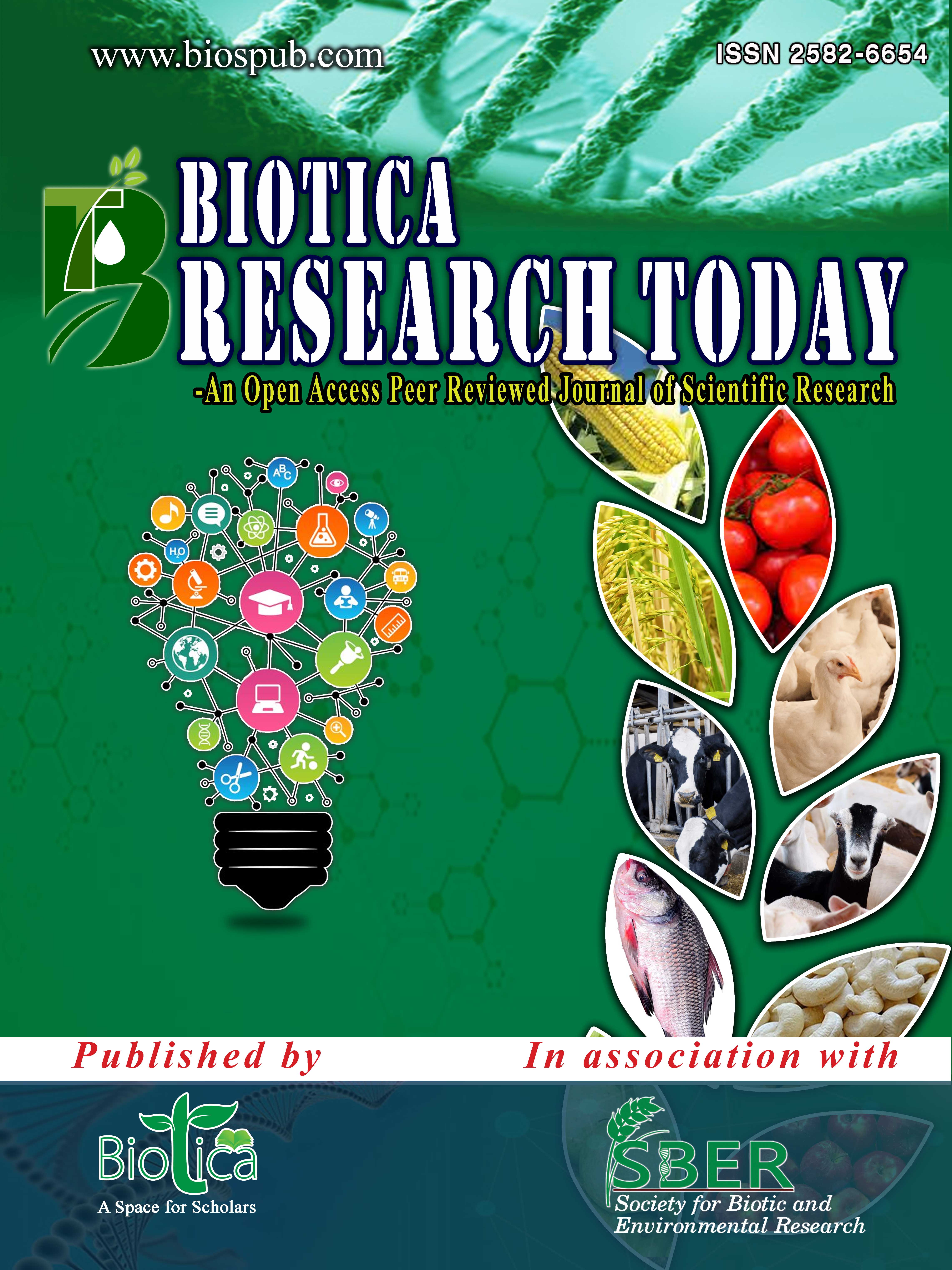Host Reaction of Some Local Tomato Varieties against Root Knot Nematode, Meloidogyne incognita (Kofoid and White) Chitwood
DOI:
https://doi.org/10.54083/ResBio/5.4.2023/153-157Keywords:
Gall index, Resistant, Root knot nematode, Susceptible, Tomato, VarietiesAbstract
An experiment was conducted for the investigations on screening on different local tomato varieties against RKN, Meloidogyne incognita under net house conditions during the year 2021-22. Out of thirty-five varieties only four (Abhimanyu, HY- Rocky, HY- 1276 and HY-Red Boar) were found to be moderately resistant to the nematode having root gall index between 2.1 to 3.0. Twenty-one varieties were found to be susceptible having root gall index between 3.1 to 4.0, but the remaining varieties were quite vulnerable to the nematode having root gall index between 4.1 to 5.0. Additionally, it was discovered that, in comparison to the other tomato types, Amlan and HY-3682 (Special) had the most gall infestation. All the varieties showed significant differences in their responses or reactions to root-knot nematodes from moderately resistant to vulnerable.
Downloads
References
Anwar, S.A., Mckenry, M.V., 2010. Incidence and reproduction of Meloidogyne incognita on vegetable crop genotypes. Pakistan Journal of Zoology 42(2), 135-141.
Casteel, C.L., Walling, L.L, Paine, T.D., 2006. Behavior and biology of the tomato psyllid, Bactericerca cockerelli, in response to the Mi‐1.2 gene. Entomologia experimentalis et applicata, 121(1), 67-72. DOI: https://doi.org/10.1111/j.1570-8703.2006.00458.x. DOI: https://doi.org/10.1111/j.1570-8703.2006.00458.x
Caveness, F.E., Ogunforowa, A.O., 1985. Nematological studies worldwide. In: Cowpea Research Production and Utilization. (Eds.) Singh, S.R. and Rachie, K.O. John Wiley and Sons, New York. pp. 273-285.
Coyne, D.L., Ross, J.L., 2014. Protocol for Nematode Resistance Screening: Root Knot Nematodes, Meloidogyne spp. International Institute of Tropical Agriculture (IITA), Ibadan, Nigeria. p. 27.
Darban, D.A., Pathan, M.A., Jiskani, M.M., Wagan, K.H., 2003. Response of some tomato cultivars to root-knot nematodes, Meloidogyne incognita. Pakistan Journal of Agriculture, Agricultural Engineering and Veterinary Sciences 19(1), 36-38.
El-Sherif, A.G., Refaei, A.R., El-Nagar, M.E., Salem, H.M.M., 2007. The role of eggs inoculum level of Meloidogyne incognita on their reproduction and host reaction. African Journal of Agricultural Research 2(4), 159-163.
Jain, R.K., Mathur, K.N., Singh, R.V., 2007. Estimation of losses due to plant parasitic nematodes on different crops in India. Indian Journal of Nematology 37(2), 219-221.
Kamran, M., Anwar, S.A., Javed, M., Khan, S.A., Sahi, G.H., 2010. Incidence of root-knot nematodes on tomato in Sargodha, Punjab, Pakistan. Pakistan Journal of Nematology 28, 253-262.
Krishnappa, K., 1985. Nematology in developing countries. In: An Advanced Treatise on Meloidogyne: Biology and Control. Volume 1. (Eds.) Barker, K.R., Carter, C.C. and Sasser, J.N. Department of Plant Pathology and the USAID, North Carolina State University Graphics, Raleigh, North Carolina, USA. pp. 379-398.
Roberts, P.A., 1995. Conceptual and practical aspects of variability in root-knot nematodes related to host plant resistance. Annual Review of Phytopathology 33, 199-221. DOI: https://doi.org/10.1146/annurev.py.33.090195.001215. DOI: https://doi.org/10.1146/annurev.phyto.33.1.199
Siddiqui, M.A., Alam, M.M., 2001. Integrated management of the root-knot and reniform nematodes with cropping sequences and ploughing. Archives of Phytopathology and Plant Protection 33(5), 415-430. DOI: https://doi.org/10.1080/03235400109383363. DOI: https://doi.org/10.1080/03235400109383363
Sikora, R.A., Fernandez, E., 2022. Nematode parasites of vegetables. In: Plant Parasitic Nematodes in Subtropical and Tropical Agriculture. 2nd Edition. (Eds.) Luc, M., Sikora, R.A., Bridge, J. CAB International, UK. pp. 319-392. DOI: https://doi.org/10.1079/9780851997278.0319. DOI: https://doi.org/10.1079/9780851997278.0319
Shrestha, S., Kumar, R., Behera, T.K., Sharma, H.K., 2012. Inheritance of resistance to root-knot nematode (Meloidogyne incognita race 1) in tomato (Solanum lycopersicum L.) ‘Pusa 120’. The Journal of Horticultural Science and Biotechnology 87(3), 211-216. DOI: https://doi.org/10.1080/14620316.2012.11512854. DOI: https://doi.org/10.1080/14620316.2012.11512854
Sujatha, R., Vethamoni, P.I., Manivannan, N., Sivakumar, M., 2017. Screening of tomato genotypes for root knot nematode (Meloidogyne incognita Kofoid and White Chitwood). International Journal of Current Microbiology and Applied Sciences 6(3), 1525-1533. DOI: https://doi.org/10.20546/ijcmas.2017.603.175. DOI: https://doi.org/10.20546/ijcmas.2017.603.175
Talavera, M., Verdejo-Lucas, S., Ornat, C., Torres, J., Vela, M.D., Macias, F.J., Cortada, L., Arias, D.J., Valero, J., Sorribas, F.J., 2009. Crop rotations with Mi gene resistant and susceptible tomato cultivars for management of root-knot nematodes in plastic houses. Crop Protection 28(8), 662-667. DOI: https://doi.org/10.1016/j.cropro.2009.03.015. DOI: https://doi.org/10.1016/j.cropro.2009.03.015
Tariq, M., Khan, T.A., Akhtar, G., Khan, N., 2016. Screening of fenugreek (Trigonella foenum-Graecum) varieties against root-knot nematode Meloidogyne incognita. Journal of Plant Pathology and Microbiology 7(2), 335. DOI: https://doi.org/10.4172/2157-7471.1000335. DOI: https://doi.org/10.4172/2157-7471.1000335
Taylor, A.L., Sasser, J.N., 1978. Biology, identification and control of root-knot nematodes (Meloidogyne species). Dept. of Plant Pathology, North Carolina State University and the United States Agency for International Development, Raleigh. p. 111.
Whitehead, A.G., Hemming, J.R., 1965. A comparison of some quantitative methods extracting small vermiform nematodes from the soil. Annals of Applied Biology 55(1), 25-38. DOI: https://doi.org/10.1111/j.1744-7348.1965.tb07864.x. DOI: https://doi.org/10.1111/j.1744-7348.1965.tb07864.x
Downloads
Published
How to Cite
Issue
Section
License
Copyright (c) 2023 Research Biotica

This work is licensed under a Creative Commons Attribution-NonCommercial-NoDerivatives 4.0 International License.
Submission of a manuscript implies that when the manuscript is accepted for publication, the authors agree to automatic transfer of the copyright to the publisher (or grant the Publisher exclusive publication and dissemination rights). The Biotica, as the publisher, has the right to enter into any agreement with any organization in India or abroad engaged in reprography, photocopying, storage and dissemination of information contained in this journal. The Biotica has no objection in using the material, provided the information is being utilized for academic purpose but not for commercial use. Due credit line should be given to Biotica where information will be utilized.









 |
|


